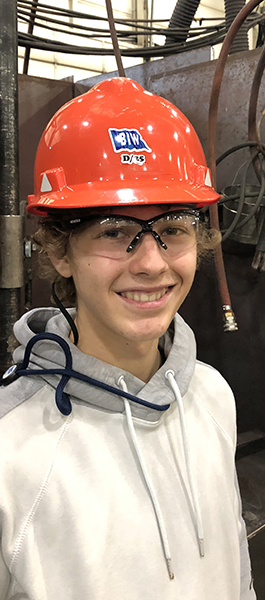
Most apprentices complete an 8,000-hour Apprenticeship within one of the craft areas listed below (approximately 4-years). An academic curriculum consisting of 60-college credits complements on-the-job training with a strong foundation in shipbuilding discipline theory and prepares the apprentice to further their education.
Carpenter
Ship’s Carpenters build, install, and remove rough wooden structures, temporary frame shelters, and protective covering for ship’s equipment. They also assemble, install, and repair ship furnishings, such as doors, lockers, cabinets, desks, and berths.
Insulator
Insulators insulate ship compartments, walls, bulkheads and overheads for climate and noise control. They also insulate pipe and ventilation systems for anti-sweat protection and heat transmittal protection.
Machinist
Machinists set up and run all the manually controlled machines in the Machine Shop and Fabrication Shops. Machinist apprentices also learn to operate computer numerically controlled (CNC) machines – including boring mills, lathes, and milling machines. They work a wide variety of metals to produce valves, bolts, shafts, bushings, and other close tolerance machined parts.
Maintenance Electric & HVAC
Maintenance Electric & HVAC install and repair all the electrical systems for the buildings and cranes in the shipyard. This includes supply wiring, branch circuit wiring, and the equipment itself. Additionally, this group installs, maintains, and repairs all the heating, ventilation, and air conditioning systems in the shipyard.
Maintenance Mechanic
Maintenance Mechanics install, repair and maintain all the machinery, mobile equipment, cranes, and all the structural buildings for the shipyard. Besides working on doors, floors, ceilings, and cabinets in buildings.
Marine Electrician
Marine Electricians install electrical equipment, foundations for equipment, cable runs, cut in and hook up equipment, and perform testing on finished systems.
Outside Machinist
Outside Machinists install and test all the machinery which include the engines, shafting, and generators, pumps, propellers, rudders, as well as the ordnance equipment on the ship.
Pipefitter
Pipefitter apprentices install, inspect and test all shipboard piping systems. They learn the characteristics of steel, copper, copper-nickel and stainless steel pipe. Training typically starts in the pipe fabrication shop, with lessons in welding, burning, brazing, and configuring pipe, and culminates in the installation and testing of shipboard piping systems.
Preservation Tech (Painter)
This craft prepares surfaces and selects the methods of coating application. They apply special hull treatments to protect and enhance the operations and appearance of ships.
Stagebuilder
Stagebuilders assemble a variety of steel, pipe and wood staging for other trades, provide all the blocking and shoring the ship sits on during initial construction and move large sections as the ship is being assembled.
Structural Fitter
Structural Fitter apprentices contribute to all structural phases of the ship’s hull construction, including fabrication, assembly and alignment of the ship structure. They typically build in-place all interior structures, hatches, doors, and bulkheads to complete the steel work of the ship.
Tinsmith
Tinsmith apprentices are responsible for the majority of the interior finish work on naval vessels. They utilize welding qualifications and trade theory to manipulate sheet metal to fabricate shipboard bunks, lockers, stowage bins, workbenches, furniture, bulkheads, ventilation, doors, ladders, and handrails.
Welder
Welding apprentices learn the full range of manual, semiautomatic and automatic welding processes in the shipyard. They use a wide range of metals and welding processes to perform structural and pipe welds in all phases of ship construction.
Yard Rigger
Riggers learn to properly hook up loads and signal cranes to pick up and move components to locations aboard ships.
Planning Technician
Planning technician apprentices become proficient in the use of various computer systems that are used for planning and controlling work on various product lines. They will rotate through related work areas to become experienced in program planning and scheduling, work breakdown structure, operational planning and shop floor planning.
Marine Design
(Two Programs: Basic 4,000 hr. and Advanced 4,000 hr.)
Apprentices selected for this program will prepare a variety of engineering documents including drawings, liaison and discrepancy reports. Students will utilize PC-based design software including computer-aided drafting and specification/technical libraries. Design students will take courses specifically developed for the Marine Design apprenticeship including marine engineering and naval architecture.
Basic Design Apprentices take courses work leading to a Certificate of Marine Design from SMCC. Click here to learn more.
Advanced Design Apprentices transfer their SMCC credits to Maine Maritime Academy and take coursework leading to an Associate’s of Science in Ship Design from Maine Maritime Academy (similar to Manufacturing Trades and Planning Technicians).
